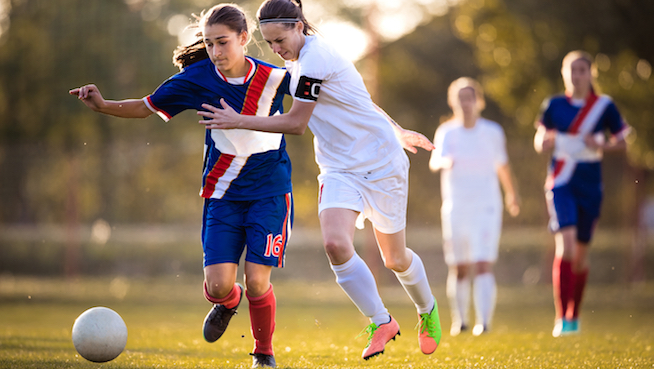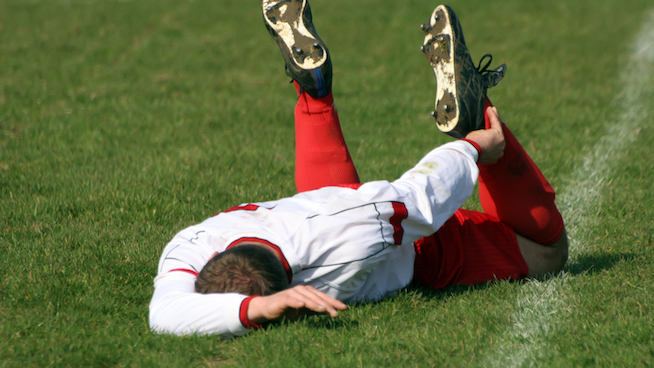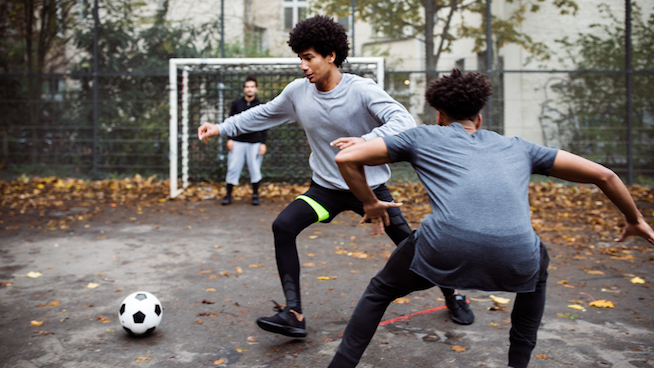5 Training Mistakes Slowing Down the Progress of Youth Soccer Players
Soccer legend Johan Cruyff could not have said it any better: “Soccer is simple.”
Nowadays, however, this profound message seems to be lost. Especially in youth soccer, there is a lot of fluff when it comes to technical training, conditioning and performance training.
Spoiler alert: We can develop talented soccer players by keeping things simple. Whenever it comes to kids, the default should always be simplicity. Still, there many mistakes I see in youth soccer training, and almost all of them relate to overcomplicating things. With that in mind, here are five mistakes slowing down the progress of many youth soccer players.
1. Moving on From Fundamentals Too Fast
Not giving young soccer players the time to master their fundamentals sets them up for failure. If they don’t have a mastery of the basic skills, how can we expect them to execute them during the chaotic nature of a game?
“Repetition is the mother of learning.” It’s a coaching mantra I have followed my entire career. When it comes to mastering the fundamentals, there’s simply zero replacement for putting in the repetitions.
Take the drill above, for example. You may find a kid has to perform those initial progressions over and over and over again before they’re able to master it. That’s OK! Repetition should be a staple of their ball mastery programming.
So that brings me to this challenging question: You know that 8-year-old attached to a speed harness while dancing through agility rings while volleying the ball back to his technical trainer? Is that effective?
Moreover, what are they working on here? Volleys? Footwork? Both? Why the speed harness? Has the kid mastered the volleys yet to be able to do them with resistance? Also, what is the point of the speed harness? That’s a lot of questions raised by a single drill, and I’m not sure all of them have convincing answers.
This isn’t to say these trainers are wrong, but your best bet is choosing one or two skills, whether that is passing or first touch or volley technique, for a kid to hone in during a session or maybe even over several sessions.
Once the player has the technique down, move on to more advanced progressions. But you may find that the flashiest drills have little ability to carry over to the game. Again, listen to Cruyff: Keep. It. Simple.
2. Ignoring Full-Body Strength and Balance
Youth soccer is full of varying body types, stages of maturation and physical abilities. Across the board kids should start by learning how to control their own body weight efficiently. Not only does this help with preventing injury, but functional strength and balance are key to executing the technical aspects of the game.
Better balance equals improvement in:
- Being able to plant the foot for a clean strike on goal
- Being able to plant the foot and explode out of a 1v1 move
- Being able to land on one foot after going up for a head ball
- Being able to withstand force and stay injury-free
Expounding further, better functional full-body strength equals improvement in:
- Increased maximal speed
- Increased change of direction ability
- Improved shooting
- Improved acceleration and deceleration
- Increased confidence
- Improved body composition
For youth players, training doesn’t mean signing a kid up for CrossFit. To start out, they can build total body reflexive strength by doing simple bodyweight drills such as this drill as well as the one shown above:
3. Not Enough Technical Training Under Pressure

Ball mastery skills are critical for confidence on the ball, but in order to make them transferable to the game, they need to be progressed with pressure situations.
If a kid has a high training age, meaning he or she has been mastering his technical game with a trainer or coach for several years, it is time to up the ante for his or her continued development.
At this point, I don’t care if they can do a static scissors move anymore. Now, can they do it with a defender pressuring them? Can they do it organically in the flow of a real game situation?
Funny enough, I’ve seen players who can perform a move perfectly while standing still, but when performing them on the run against a defender, they crack under the pressure. Once the fundamental movement has been mastered, it must be progressed so the athlete can execute it under pressure.
4. Ignoring Recovery Windows

Soccer is now a year-round sport for many kids.
In fact, I’m not sure what the word “offseason” really means anymore. Indoor. Outdoor. High school ball. Futsal. Camps. College ID camps. It is an exhausting list of soccer shenanigans that can lead to a few things:
- Mental burn out
- Overuse injury
- Loss of passion for game
- Exhaustion
- Stress
- Decreased social life
Remember, sometimes kids need to be kids. Studies have found some not-so-great associations with early specialization, but if you are going to specialize, you need to build in some time off throughout the year. I think it is fair to say taking 1-3 months off of soccer in a year will not deplete a child’s skills or capacity to play the beautiful game. In contrast, that time off will allow them to regain zest for the sport, reduce their chance of overuse injury and give them time to just enjoy life as a kid.
5. Not Playing Pick-Up Soccer

Sure, team practices and organized drills are great for teaching moments and ensuring kids learn. But more often than not, kids need to be playing in a more “unorganized” environment to complement and develop this organized training.
Many of the best soccer players in the world came up playing hours of pick-up soccer a day during their childhood.
No drills. No cones. No rules. No limitations.
Pick-up soccer inspires creativity, improves spontaneous decision-making, rewards team-focused play, and allows players to practice skills in game-like situations without the pressure of it being an actual game.
Soccer also encourages kids to get outside, play, and be carefree. No more video games, SnapChat, or Instagram. Just the ball, a field and good times.
These five mistakes are some of the most common that I see when I look across the youth soccer landscape. The good news is they’re simple to fix. Focus on mastery of the basics over flashy drills, strive to build great balance and functional bodyweight strength instead of impressive weight room numbers, allow kids time to recover throughout the year, and encourage lots of participation in pick-up games. These simple steps will help youth soccer players stay on a path of steady improvement and gradually enhance their improvement on the field.
READ MORE:
RECOMMENDED FOR YOU
MOST POPULAR
5 Training Mistakes Slowing Down the Progress of Youth Soccer Players
Soccer legend Johan Cruyff could not have said it any better: “Soccer is simple.”
Nowadays, however, this profound message seems to be lost. Especially in youth soccer, there is a lot of fluff when it comes to technical training, conditioning and performance training.
Spoiler alert: We can develop talented soccer players by keeping things simple. Whenever it comes to kids, the default should always be simplicity. Still, there many mistakes I see in youth soccer training, and almost all of them relate to overcomplicating things. With that in mind, here are five mistakes slowing down the progress of many youth soccer players.
1. Moving on From Fundamentals Too Fast
Not giving young soccer players the time to master their fundamentals sets them up for failure. If they don’t have a mastery of the basic skills, how can we expect them to execute them during the chaotic nature of a game?
“Repetition is the mother of learning.” It’s a coaching mantra I have followed my entire career. When it comes to mastering the fundamentals, there’s simply zero replacement for putting in the repetitions.
Take the drill above, for example. You may find a kid has to perform those initial progressions over and over and over again before they’re able to master it. That’s OK! Repetition should be a staple of their ball mastery programming.
So that brings me to this challenging question: You know that 8-year-old attached to a speed harness while dancing through agility rings while volleying the ball back to his technical trainer? Is that effective?
Moreover, what are they working on here? Volleys? Footwork? Both? Why the speed harness? Has the kid mastered the volleys yet to be able to do them with resistance? Also, what is the point of the speed harness? That’s a lot of questions raised by a single drill, and I’m not sure all of them have convincing answers.
This isn’t to say these trainers are wrong, but your best bet is choosing one or two skills, whether that is passing or first touch or volley technique, for a kid to hone in during a session or maybe even over several sessions.
Once the player has the technique down, move on to more advanced progressions. But you may find that the flashiest drills have little ability to carry over to the game. Again, listen to Cruyff: Keep. It. Simple.
2. Ignoring Full-Body Strength and Balance
Youth soccer is full of varying body types, stages of maturation and physical abilities. Across the board kids should start by learning how to control their own body weight efficiently. Not only does this help with preventing injury, but functional strength and balance are key to executing the technical aspects of the game.
Better balance equals improvement in:
- Being able to plant the foot for a clean strike on goal
- Being able to plant the foot and explode out of a 1v1 move
- Being able to land on one foot after going up for a head ball
- Being able to withstand force and stay injury-free
Expounding further, better functional full-body strength equals improvement in:
- Increased maximal speed
- Increased change of direction ability
- Improved shooting
- Improved acceleration and deceleration
- Increased confidence
- Improved body composition
For youth players, training doesn’t mean signing a kid up for CrossFit. To start out, they can build total body reflexive strength by doing simple bodyweight drills such as this drill as well as the one shown above:
3. Not Enough Technical Training Under Pressure

Ball mastery skills are critical for confidence on the ball, but in order to make them transferable to the game, they need to be progressed with pressure situations.
If a kid has a high training age, meaning he or she has been mastering his technical game with a trainer or coach for several years, it is time to up the ante for his or her continued development.
At this point, I don’t care if they can do a static scissors move anymore. Now, can they do it with a defender pressuring them? Can they do it organically in the flow of a real game situation?
Funny enough, I’ve seen players who can perform a move perfectly while standing still, but when performing them on the run against a defender, they crack under the pressure. Once the fundamental movement has been mastered, it must be progressed so the athlete can execute it under pressure.
4. Ignoring Recovery Windows

Soccer is now a year-round sport for many kids.
In fact, I’m not sure what the word “offseason” really means anymore. Indoor. Outdoor. High school ball. Futsal. Camps. College ID camps. It is an exhausting list of soccer shenanigans that can lead to a few things:
- Mental burn out
- Overuse injury
- Loss of passion for game
- Exhaustion
- Stress
- Decreased social life
Remember, sometimes kids need to be kids. Studies have found some not-so-great associations with early specialization, but if you are going to specialize, you need to build in some time off throughout the year. I think it is fair to say taking 1-3 months off of soccer in a year will not deplete a child’s skills or capacity to play the beautiful game. In contrast, that time off will allow them to regain zest for the sport, reduce their chance of overuse injury and give them time to just enjoy life as a kid.
5. Not Playing Pick-Up Soccer

Sure, team practices and organized drills are great for teaching moments and ensuring kids learn. But more often than not, kids need to be playing in a more “unorganized” environment to complement and develop this organized training.
Many of the best soccer players in the world came up playing hours of pick-up soccer a day during their childhood.
No drills. No cones. No rules. No limitations.
Pick-up soccer inspires creativity, improves spontaneous decision-making, rewards team-focused play, and allows players to practice skills in game-like situations without the pressure of it being an actual game.
Soccer also encourages kids to get outside, play, and be carefree. No more video games, SnapChat, or Instagram. Just the ball, a field and good times.
These five mistakes are some of the most common that I see when I look across the youth soccer landscape. The good news is they’re simple to fix. Focus on mastery of the basics over flashy drills, strive to build great balance and functional bodyweight strength instead of impressive weight room numbers, allow kids time to recover throughout the year, and encourage lots of participation in pick-up games. These simple steps will help youth soccer players stay on a path of steady improvement and gradually enhance their improvement on the field.
READ MORE:










